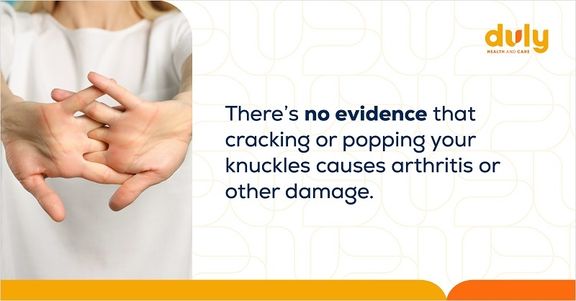You’ve always loved cracking your fingers – even though every time you do, you hear a nagging voice in your head saying, “Don’t crack your knuckles or you’ll get arthritis.”
But is cracking joints actually bad for you?
You can rejoice if you’re a habitual knuckle cracker. That old warning is just a myth.

In fact, you can usually crack or pop other joints, like those in your wrists, neck, or back, without affecting function or causing serious problems (although you might annoy people around you with the sound).
Why Joint Cracking Feels So Good
There are a few reasons why cracking or popping joints is so satisfying.
One is that it increases your joint’s range of motion. Another has to do with synovial fluid, which is a thick liquid between your joints that cushions and lubricates the joints.
Gas bubbles can build up in the synovial fluid. Cracking a joint causes a change in pressure, which pops the bubbles. When this happens, your brain responds by releasing a bit of dopamine (known as the “feel good” hormone).
The Dos and Don’ts of Joint Cracking
Cracking joints may be generally safe, but that doesn’t mean there aren’t any risks involved. If you don’t crack a joint correctly, you could injure your ligaments (tissues that connect your bones to one another) or make an existing problem worse.
This is especially true if you’re trying to crack your neck or back. Incorrect cracking could lead to muscle strain or more serious problems, like herniated discs, broken ribs, or pinched nerves.
Here’s what to do and what not to do when it comes to cracking your back or neck.
Do
- Start exercises with a professional like a physiotherapist to learn proper form
- Stretch slowly and gently
- Only hold a stretch for a few seconds
- Start slow – if you want to increase how long you hold a stretch, do so gradually
- Stop if you feel intense pain
Don’t
- Have someone who isn’t a medical professional try to crack your joint
- Twist your jaw or grab your head and jaw
- Stretch beyond your comfort level
- Crack your back if you have a spine or neck injury, cancer of the spine, moderate or severe osteoporosis, are at high risk for a stroke, or are in the third trimester of pregnancy
Safe Ways to Crack and Pop Your Joints
Here are some stretches you can do instead of cracking your own neck and back.
Stretches to Crack Your Back
Cat Cow (sometimes called Cat Camel)
- Start on all fours with your knees and hands hip-width apart. Make sure your knees are under your hips and your wrists are under your shoulders.
- Get into “cat” position. Breathe in and round your back by pushing your spine upward. Draw your belly button into your spine and keep your head tucked down. Hold for 5 seconds.
- Move into “cow” position. Breathe in and arch your back, while dropping your stomach to the ground and moving your head to look upward. Hold for 5 seconds.
- Repeat 10 times in each direction.
Foam Roller Stretch
- Put a foam roller on the ground horizontally.
- Lay down and rest your back against the top of the roller while keeping your knees bent and feet flat on the ground. Put your hands behind your neck (or across your chest if that hurts your shoulders).
- Inhale deeply. When you breathe out, extend your back over the roller, toward the ground.
- Hold for 5 seconds.
- Repeat 20 times.
Standing Back Twist
- Stand with your feet and hips facing forward. Keep your feet shoulder-width apart.
- With your feet and hips facing forward, slowly twist your upper body to the left.
- Hold for a few seconds and return to center.
- Do the same movement on your right.
Also read: The Aging Spine
Stretches to Crack Your Neck
Foam Roller Stretch
- Lie on your back. Keep your knees bent and feet flat on the ground.
- Put a foam roller behind your head, resting it in the arch of your neck.
- Slowly turn your head from side to side. Pause at the end of every turn.
- Turn your head as far as you can while remaining comfortable.
- Repeat 10 to 15 times on both sides.
Chiropractic Adjustments
Adjustments are treatments where a chiropractor (a specialist who treats the nervous system and musculoskeletal problems like joint pain) gently realigns your joints. This improves your range of motion and decreases pain.
During treatment, the chiropractor applies controlled pressure to the joint and moves it beyond its normal range of motion. As they move your joints, you may hear popping or cracking sounds. Don’t be alarmed if the noise is louder than you would expect – it doesn’t mean that anything is wrong.
You might hear adjustments referred to as “manipulations.” The thought of manipulating a joint might be a bit scary, but it’s nothing to fear. Adjustments cause little to no pain, like what you may feel after exercising. Minor side effects like soreness are temporary. It’s very rare to have serious side effects or complications.
Also read: Physical Therapy and Chiropractic Care – What’s the Difference?
When to Get Care From an Expert
While cracking your joints because you like doing so typically won’t cause issues, feeling like you need to crack them could be a red flag. Cracking or popping a joint offers temporary relief, but it doesn’t necessarily solve the underlying problem.
You may want to get medical care if you have symptoms like:
- Pain that doesn’t go away
- Chronic stiffness or tension
- Popping or cracking your joint makes it feel worse
- Numbness, tingling, blurry vision, or headaches
- Neck pain with a severe headache
- Fever or chills
These could be signs of problems, like an injury or bad habits like sitting for long periods of time, that bring on pain. Once your provider finds out why you’re having pain, they can help you treat the issue or make lifestyle adjustments so that you no longer constantly feel the need to crack or pop a joint.
But in the meantime – snap, crackle, and pop away!
Also read: Understanding Pain Management Options
Don’t ignore persistent joint discomfort or the constant urge to crack your joints. If you’re experiencing ongoing pain, stiffness, or feel compelled to crack your joints throughout the day, schedule an appointment with a Duly Health and Care orthopedic specialist who can evaluate your joint health and identify any underlying problems.
For those seeking natural pain relief and improved mobility, our experienced chiropractors offer gentle adjustments and personalized treatment plans to address joint dysfunction at its source. Take control of your joint health today and schedule an appointment to get lasting relief.
Health Topics:



